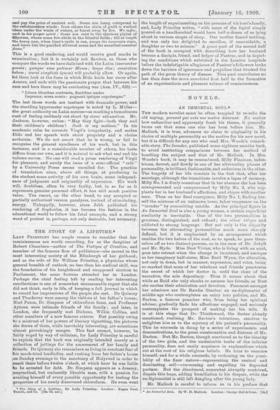NOVELS.
AN IMMORTAL SOUL.*
THE modern novelist must be often tempted to re-echo the old saying, pereant qui ante nos nostra dixerunt. No matter how unfamiliar and apparently fresh his theme, it generally turns out that some one else has been before him. , Mr. Matlock, it is true, advances no claim to originality in his choice of multiple personality as the motive for his new novel, but it is difficult for any one who read Mrs. Woods's remark- able story, The Invader, published some eighteen months hack, to avoid instituting comparisons between her method of handling the subject and that of Mr. Mallock. In Mrs. Woods's book, it may be remembered, Milly Flaxman, indus- trious, devout, and dowdy in one of her alternating phases of personality, is brilliant, fashionable, and audacious in the other. The tragedy of her life consists in the fact that, after her marriage, although the transitions involve a lapse of memory, Milly No. 1 is dimly conscious that in her absence she has been misrepresented and compromised by Milly No. 2, who plants her in her husband's affections, and elopes with another man. Thus on her final emergence, Milly No. 1, finding her- self the mistress of an unknown lover, takes vengeance on the "invader" by committing suicide. As the principal figure in An Immortal Soul is also a young woman, a certain superficial similarity is inevitable. One of the two personalities is gracious, distinguished, and refined ; the other vulgar and addicted to strong language. But not only is the disparity between the alternating personalities much more sharply defined, but it is emphasised by an arrangement which enables the two halves of the soul, so to speak, to pass them- selves off as two distinct persons, as in the case of Dr. Jekyll and Mr. Hyde. Miss Nest Vivian, who is living with an aunt, goes into retreat when the change is imminent, and emerges as her imaginary half-sister, Miss Enid Wynn, the alteration, not only in dress, but in manner, expression, and voice, being so marked that none of her relations and friends penetrates the secret of which her doctor is, until the close of the narrative, the sole depositary. Thus it Conies about that while as Enid she only shocks or amuses her friends, as Nest she excites their admiration and devotion. Foremost amongst her admirers are Sir Rawlin Stantor, an ex-diplomatist of middle age who contemplates an entry into politics, and Mr. Barton, a famous preacher who, from being her spiritual adviser, gradually finds his affections engaged, and seriously contemplates the prospect of making her his wife. It is at this stage that Dr. Thistlewood, the doctor already mentioned, realising Mr. Barton's intentions, resolves to enlighten him as to the mystery of his patient's personality. This he succeeds in doing by a series of experiments and demonstrations, to the great consternation and distress of Mr. Barton. But Mr. Barton, though convinced as to the identity of the two girls, and the undesirable traits of the inferior personality, does not easily acquiesce in explanations which cut at the root of his religious beliefs. He tries to reassure himself, and for a while succeeds, by reckoning on the possi- bility of the finer nature—representing the central and dominating self—overcoming and expelling its degraded partner. But the denoliment, somewhat abruptly contrived, dispels this hope, adding humiliation to his despair, while the ex-diplomatist is still left dangling after the young lady.
Mr. Mallock is careful to inform us in his preface that
• An Immortal Soul. By W. H. Mallook. London: George Bell & Sous. [64.]
" every abnormal incident introduced into the present work IS in close accordance with phenomena observed and recorded by scientific students during the last quarter of a century, and especially during the last ten years." That we can readily believe, for the chapters relating to Dr. Thistlewood's experiments are so copiously " documented " as to resemble a medical treatise rather than a novel. But this assurance affords no guarantee that the book will be satisfying as a work of art or convincing as a narrative. As a matter of fact, though Mr. Mallock defines his aim as "to provide phenomena which are representative, although they are rare, with a setting which shall be representative because it is common," the net result of this dovetailing of alleged scientific fact with fiction Is extremely artificial. There is a good deal of excellent description ; some elaborate portraiture of society personages In the Disraelian vein ; much conversation on high and abstruse topics ; and an elaborate analysis of the searobings of conscience, doubts, and fears of the unfortunate Mr. Barton, who is himself a representative of dualism of the more normal tYpe. If the general impression is disappointing, the best explanation is to be found in Mr. Mallock's admission that the book had "been cast experimentally into several forms," and therefore leeks the continuity and coherence which inform a work animated by a single purpose.





































 Previous page
Previous page